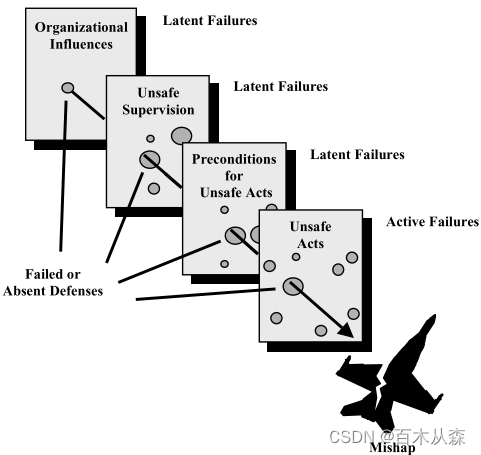写在最后
在结束之际,我想重申的是,学习并非如攀登险峻高峰,而是如滴水穿石般的持久累积。尤其当我们步入工作岗位之后,持之以恒的学习变得愈发不易,如同在茫茫大海中独自划舟,稍有松懈便可能被巨浪吞噬。然而,对于我们程序员而言,学习是生存之本,是我们在激烈市场竞争中立于不败之地的关键。一旦停止学习,我们便如同逆水行舟,不进则退,终将被时代的洪流所淘汰。因此,不断汲取新知识,不仅是对自己的提升,更是对自己的一份珍贵投资。让我们不断磨砺自己,与时代共同进步,书写属于我们的辉煌篇章。
需要完整版PDF学习资源私我
网上学习资料一大堆,但如果学到的知识不成体系,遇到问题时只是浅尝辄止,不再深入研究,那么很难做到真正的技术提升。
一个人可以走的很快,但一群人才能走的更远!不论你是正从事IT行业的老鸟或是对IT行业感兴趣的新人,都欢迎加入我们的的圈子(技术交流、学习资源、职场吐槽、大厂内推、面试辅导),让我们一起学习成长!
* [2.1.1.2 Decision errors](#2112_Decision_errors_81)
* [2.2.1.3 Perceptual errors](#2213_Perceptual_errors_98)
- [2.1.2 Violations](#212_Violations_107)
- * [2.1.2.1 Routine violations](#2121_Routine_violations_112)
* [2.1.2.2 Exceptional violations](#2122_Exceptional_violations_121)
+ [2.2 Preconditions for Unsafe Acts](#22_Preconditions_for_Unsafe_Acts_156)
+ - [2.2.1 Substandard Conditions of Operators](#221_Substandard_Conditions_of_Operators_162)
- * [2.2.1.1 Adverse mental states](#2211_Adverse_mental_states_163)
* [2.2.1.2 Adverse physiological states](#2212_Adverse_physiological_states_172)
* [2.2.1.3 Physical/Mental Limitations](#2213_PhysicalMental_Limitations_181)
- [2.2.2 Substandard Practices of Operators](#222_Substandard_Practices_of_Operators_196)
- * [2.2.2.1 Crew Resource Mismanagement](#2221_Crew_Resource_Mismanagement_201)
* [2.2.2.2 Personal Readiness](#2222_Personal_Readiness_211)
+ [2.3 Unsafe Supervision](#23_Unsafe_Supervision_250)
+ - [2.3.1 Inadequate Supervision](#231_Inadequate_Supervision_253)
- [2.3.2 Planned Inappropriate Operations](#232_Planned_Inappropriate_Operations_262)
- [2.3.3 Failure to Correct a Known Problem](#233_Failure_to_Correct_a_Known_Problem_274)
- [2.3.4 Supervisory Violations](#234_Supervisory_Violations_283)
+ [2.4 Organizational Influences](#24_Organizational_Influences_308)
+ - [2.4.1 Resource Management](#241_Resource_Management_313)
- [2.4.2 Climate](#242_Climate_322)
- [2.4.3 Operational Process](#243_Operational_Process_331)
1 来源
人的因素分析与分类系统(Human Factors Analysis and Classification System, HFACS)是基于Reason的瑞士奶酪模型提出的,它细化了各层内容。
该模型是Scott Shappell和Douglas A Wiegmann两人著作,由Office of Aviation Medicine Washington, DC(美国华盛顿特区航空医学办公室)发布,受U.S. Department of Transportation(美国运输部)赞助。
HFACS最早主要应用于航空事故分析,后经学者们修改,也应用于航海事故、煤矿事故、电力事故等的分析中, HFACS各层内容未做精确定义,原因因素依靠人为列举,影响了其在更广阔领域的应用。
2 拟解决的问题(背景)
70%到80%的民用和军用航空事故都与人为失误有关。然而,大多数事故报告系统并没有围绕任何人为错误的理论框架设计。因此,大多数事故数据库都不利于传统的人为错误分析,使得干预策略的确定十分繁琐。所需要的是一个普遍的人为错误框架,可以围绕它设计新的调查方法,并重组现有的事故数据库。
Human error has been implicated in 70 to 80% of all civil and military aviation accidents. Yet, most accident reporting systems are not designed around any theoretical framework of human error. As a result, most accident databases are not conducive to a traditional human error analysis, making the identification of intervention strategies onerous. What is required is a general human error framework around which new investigative methods can be designed and existing accident databases restructured.
那么,文献中反复提到的70- 80%的人为错误到底是由什么构成的呢?有些人会让我们相信,人为错误和“飞行员”错误是同义词。然而,简单地将航空事故仅仅归咎于飞行员的失误,是一种过于简单,甚至是幼稚的事故起因分析方法。毕竟,众所周知,事故不能归咎于单一原因,或者在大多数情况下,甚至不能归咎于单个人(Heinrich, Petersen, and Roos, 1980)。事实上,即使是确定一个“主要”原因也充满了问题。相反,航空事故是许多原因的最终结果,只有最后一个是机组人员的不安全行为(Reason,1990;Shappell & Wiegmann, 1997a;Heinrich, Peterson, & Roos, 1980;Bird,1974)。
So what really constitutes that 70-80 % of human error repeatedly referred to in the literature? Some would have us believe that human error and “pilot” error are synonymous. Yet, simply writing off aviation accidents merely to pilot error is an overly simplistic, if not naive, approach to accident causation. After all, it is well established that accidents cannot be attributed to a single cause, or in most instances, even a single individual (Heinrich, Petersen, and Roos, 1980). In fact, even the identification of a “primary” cause is fraught with problems. Rather, aviation accidents are the end result of a number of causes, only the last of which are the unsafe acts of the aircrew (Reason, 1990; Shappell & Wiegmann, 1997a; Heinrich, Peterson, & Roos, 1980; Bird, 1974).
Reason人为错误的“瑞士奶酪”模型
Reason’s “Swiss Cheese” Model of Human Error
 James Reason(1990)提出了一种特别吸引人的研究人为错误起源的方法。通常被称为人为错误的“瑞士奶酪”模型,原因描述了四个层次的人为错误,每一个都影响下一个(上图)。从事故往回看,第一个层次描述了那些最终导致事故的操作人员的不安全行为。在航空领域,这通常被称为机组人员/飞行员的错误,这是大多数事故调查工作的重点,因此,大多数原因都被发现。
James Reason(1990)提出了一种特别吸引人的研究人为错误起源的方法。通常被称为人为错误的“瑞士奶酪”模型,原因描述了四个层次的人为错误,每一个都影响下一个(上图)。从事故往回看,第一个层次描述了那些最终导致事故的操作人员的不安全行为。在航空领域,这通常被称为机组人员/飞行员的错误,这是大多数事故调查工作的重点,因此,大多数原因都被发现。
One particularly appealing approach to the genesis of human error is the one proposed by James Reason (1990). Generally referred to as the “Swiss cheese” model of human error, Reason describes four levels of human failure, each influencing the next (Figure 1). Working backwards in time from the accident, the first level depicts those Unsafe Acts of Operators that ulti mately led to the accident1. More commonly referred to in aviation as aircrew/pilot error, this level is where most accident investigations have focused their efforts and consequently, where most causal factors are uncovered.
然而,使“瑞士奶酪”模型在事故调查中特别有用的是,它迫使调查人员也在事件的因果序列中解决潜在的错误。 顾名思义,潜在错误与主动错误不同,可能潜伏或未被发现几个小时、几天、几周甚至更长时间,直到有一天它们对可疑的机组人员产生不利影响。 因此,即使是出于好意的调查人员也可能忽视它们。
However, what makes the “Swiss cheese” model particularly useful in accident investigation, is that it forces investigators to address latent failures within the causal sequence of events as well. As their name suggests, latent failures, unlike their active counterparts, may lie dormant or undetected for hours, days, weeks, or even longer, until one day they adversely affect the unsuspect ing aircrew. Consequently, they may be overlooked by investigators with even the best intentions.
在这个潜在错误的概念中,Reason又描述了三个层次的人类错误。首先涉及到机组人员的状况,因为它影响性能。这一水平被称为不安全行为的先决条件,包括精神疲劳、沟通和协调能力差等条件,通常被称为机组资源管理(CRM)。不足为奇的是,如果疲劳的机组人员不能与驾驶舱内的其他人或飞机以外的个人(如空中交通管制、维修等)沟通和协调他们的活动,就会做出糟糕的决定,并经常导致错误。
Within this concept of latent failures, Reason de scribed three more levels of human failure. The first involves the condition of the aircrew as it affects perfor mance. Referred to as Preconditions for Unsafe Acts, this level involves conditions such as mental fatigue and poor communication and coordination practices, often referred to as crew resource management (CRM). Not surprising, if fatigued aircrew fail to communicate and coordinate their activities with others in the cockpit or individuals external to the aircraft (e.g., air traffic con trol, maintenance, etc.), poor decisions are made and errors often result.
但是,究竟是什么原因导致沟通和协调在一开始就出现了问题呢?这也许就是Reason的工作与处理人为错误的更传统方法的不同之处。在许多情况下,良好的CRM实践的失败可以追溯到不安全监管的实例,这是人为失误的第三级。例如,如果两名缺乏经验(甚至可能低于平均水平的飞行员)的飞行员配对,在已知的恶劣天气的夜间飞行,有人真的会对悲剧的结果感到惊讶吗?更糟糕的是,如果这种有问题的人员配备,再加上缺乏高质量的客户关系管理培训,那么潜在的沟通错误,以及最终的机组人员错误,就会被放大。在某种意义上,机组人员被“设定”为失败,因为机组人员的协调和最终的性能将会受到损害。这并不是要减少机组人员所扮演的角色,只是说干预和缓解策略可能在系统中处于更高的位置。
But exactly why did communication and coordi nation break down in the first place? This is perhaps where Reason’s work departed from more traditional approaches to human error. In many instances, the breakdown in good CRM practices can be traced back to instances of Unsafe Supervision, the third level of human failure. If, for example, two inexperienced (and perhaps even below average pilots) are paired with each other and sent on a flight into known adverse weather at night, is anyone really surprised by a tragic outcome? To make matters worse, if this questionable manning practice is coupled with the lack of quality CRM training, the potential for mis communication and ultimately, aircrew errors, is magnified. In a sense then, the crew was “set up” for failure as crew coordination and ultimately perfor mance would be compromised. This is not to lessen the role played by the aircrew, only that intervention and mitigation strategies might lie higher within the system.
Reason模型也没有停留在监督层面;组织本身可以影响所有级别的绩效。例如,在财政紧缩时期,资金经常被削减,因此,训练和飞行时间被缩短。因此,主管常常别无选择,只能给“不熟练”的飞行员指派复杂的任务。因此,不足为奇的是,在缺乏良好的CRM培训的情况下,沟通和协调方面的失败就会开始出现,其他无数的先决条件也会出现,所有这些都会影响表现,并引发机组人员的错误。因此,如果要将事故率降低到目前的水平,调查人员和分析人员必须全面研究事故发生的顺序,并将其扩展到驾驶舱以外。最终,如果任何事故调查和预防系统要取得成功,就必须解决组织内各级的因果因素。
Reason’s model didn’t stop at the supervisory level either; the organization itself can impact perfor mance at all levels. For instance, in times of fiscal austerity, funding is often cut, and as a result, train ing and flight time are curtailed. Consequently, supervisors are often left with no alternative but to task “non-proficien








 最低0.47元/天 解锁文章
最低0.47元/天 解锁文章















 5275
5275

 被折叠的 条评论
为什么被折叠?
被折叠的 条评论
为什么被折叠?








